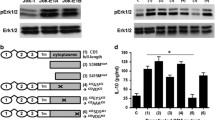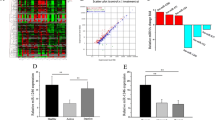Abstract
B cells play a role in the progression of multiple sclerosis (MS) and are closely related to Fc-receptor like-3 (FCRL3), but little is known about FCRL3 in B cells and MS. Activation of TLR9 in B cells with CpG found that CpG promoted FCRL3 expression in a dose- and time-dependent manner. CpG significantly activated ERK1/2, p38, and STAT3 pathways, and FCRL3 overexpression further promoted the activation of these pathways, while FCRL3 siRNA significantly inhibited the activation of these pathways by CpG. CpG stimulation significantly promoted the viability of B cells, inhibited cell apoptosis, and enhanced the production of antibodies and secretion of IL-10 by B cells. FCRL3 siRNA blocked most of the above regulatory effects of CpG, but promoted the further production of antibodies by B cells. FCRL3 overexpression enhanced the pro-survival, anti-apoptotic, and IL-10-inducing effects of CpG, but inhibited the effect of CpG on promoting antibody production. After adding inhibitors of ERK1/2, p38, and STAT3 pathways, respectively, the effects of CpG on promoting cell viability, antibody production, and IL-10 secretion were significantly reduced, but the anti-apoptotic effect of CpG was only affected by the blockade of STAT3 pathway. In addition, FCRL3 regulated B cell antibody and IL-10 secretion mainly through its ITIMs. These results indicate that TLR9 activation affects B cell proliferation, apoptosis, antibody production, and IL-10 secretion by upregulating FCRL3 expression, and is associated with ERK1/2, p38, and STAT3 pathways. Therefore, FCRL3 may be an important target for the diagnosis and treatment of B cell–related diseases.





Similar content being viewed by others
Data availability
The datasets generated during and/or analyzed during the current study are available from the corresponding author on reasonable request.
References
Abu-Rish EY, Amrani Y, Browning MJ (2013) Toll-like receptor 9 activation induces expression of membrane-bound b-cell activating factor (baff) on human b cells and leads to increased proliferation in response to both soluble and membrane-bound baff. Rheumatology (oxford) 52(7):1190–1201. https://doi.org/10.1093/rheumatology/ket006
Calahorra L, Camacho-Toledano C, Serrano-Regal MP, Ortega MC, Clemente D (2022) Regulatory cells in multiple sclerosis: from blood to brain. Biomedicines 10(2):335. https://doi.org/10.3390/biomedicines10020335
Cavallo S (2020) Immune-mediated genesis of multiple sclerosis. J Transl Autoimmun 3:100039
Cencioni MT, Ali R, Nicholas R, Muraro PA (2021) Defective CD19+CD24hiCD38hi transitional B-cell function in patients with relapsing-remitting MS. Mult Scler 27(8):1187–1197
Cui X, Liu CM, Liu QB (2020) Fcrl3 promotes il-10 expression in b cells through the shp-1 and p38 mapk signaling pathways. Cell Biol Int 44(9):1811–1819
Davis RS (2007) Fc receptor-like molecules. Annu Rev Immunol 25:525–560
Fillatreau S, Sweenie CH, McGeachy MJ, Gray D, Anderton SM (2002) B cells regulate autoimmunity by provision of il-10. Nat Immunol 3(10):944–950
Gärtner J, Hauser SL, Bar-Or A, Montalban X, Cohen JA, Cross AH et al (2022) Efficacy and safety of ofatumumab in recently diagnosed, treatment-naive patients with multiple sclerosis: Results from asclepios i and ii. Mult Scler 28(10):1562–1575
Giordani L, Sanchez M, Libri I, Quaranta MG, Mattioli B, Viora M (2009) Ifn-alpha amplifies human naive b cell tlr-9-mediated activation and ig production. J Leukoc Biol 86(2):261–271
Hanten JA, Vasilakos JP, Riter CL, Neys L, Lipson KE, Alkan SS et al (2008) Comparison of human b cell activation by tlr7 and tlr9 agonists. BMC Immunol 9:39
Haugen M, Frederiksen JL, Degn M (2014) B cell follicle-like structures in multiple sclerosis-with focus on the role of b cell activating factor. J Neuroimmunol 273(1–2):1–7
Havla J, Hohlfeld R (2022) Antibody therapies for progressive multiple sclerosis and for promoting repair. Neurotherapeutics 19(3):774–784
Hirotani M, Niino M, Fukazawa T, Kikuchi S, Yabe I, Hamada S et al (2010) Decreased il-10 production mediated by toll-like receptor 9 in b cells in multiple sclerosis. J Neuroimmunol 221(1–2):95–100
Imbrechts M, De Samblancx K, Fierens K, Brisse E, Vandenhaute J, Mitera T et al (2018) Ifn-γ stimulates cpg-induced il-10 production in b cells via p38 and jnk signalling pathways. Eur J Immunol 48(9):1506–1521
Kochi Y, Myouzen K, Yamada R, Suzuki A, Kurosaki T, Nakamura Y et al (2009) Fcrl3, an autoimmune susceptibility gene, has inhibitory potential on b-cell receptor-mediated signaling. J Immunol 183(9):5502–5510
Kumar V, Barrett JE (2022) Toll-like receptors (tlrs) in health and disease: an overview. Handb Exp Pharmacol 276:1–21
Lampropoulou V, Hoehlig K, Roch T, Neves P, Calderón Gómez E, Sweenie CH et al (2008) Tlr-activated b cells suppress t cell-mediated autoimmunity. J Immunol 180(7):4763–4773
Li FJ, Schreeder DM, Li R, Wu J, Davis RS (2013) Fcrl3 promotes tlr9-induced b-cell activation and suppresses plasma cell differentiation. Eur J Immunol 43(11):2980–2992
Liu BS, Cao Y, Huizinga TW, Hafler DA, Toes RE (2014) Tlr-mediated stat3 and erk activation controls il-10 secretion by human b cells. Eur J Immunol 44(7):2121–2129
Mion F, Tonon S, Toffoletto B, Cesselli D, Pucillo CE, Vitale G (2014) Il-10 production by b cells is differentially regulated by immune-mediated and infectious stimuli and requires p38 activation. Mol Immunol 62(2):266–276
Miyazaki Y, Niino M (2022) B-cell depletion therapy for multiple sclerosis. Immunol Med 45(2):54–62
Silva BA, Miglietta E, Ferrari CC (2021) Insights into the role of b cells in the cortical pathology of multiple sclerosis: evidence from animal models and patients. Mult Scler Relat Disord 50:102845
Song J, Deng T (2020) The adipocyte and adaptive immunity. Front Immunol 11:593058
Tao Y, Zhang X, Markovic-Plese S (2016) Toll-like receptor (tlr)7 and tlr9 agonists enhance interferon (ifn) beta-1a’s immunoregulatory effects on b cells in patients with relapsing-remitting multiple sclerosis (rrms). J Neuroimmunol 298:181–188
Vijay K (2018) Toll-like receptors in immunity and inflammatory diseases: Past, present, and future. Int Immunopharmacol 59:391–412
Volpi C, Fallarino F, Pallotta MT, Bianchi R, Vacca C, Belladonna ML et al (2013) High doses of CpG oligodeoxynucleotides stimulate a tolerogenic TLR9-TRIF pathway. Nat Commun 4:1852
Yi AK, Yoon JG, Krieg AM (2003) Convergence of cpg dna- and bcr-mediated signals at the c-jun n-terminal kinase and nf-kappab activation pathways: Regulation by mitogen-activated protein kinases. Int Immunol 15(5):577–591
Acknowledgements
We thank Yueyang Second People’s Hospital for hosting the research.
Author information
Authors and Affiliations
Corresponding author
Ethics declarations
Conflict of interest
The authors declare no competing interests.
Rights and permissions
Springer Nature or its licensor holds exclusive rights to this article under a publishing agreement with the author(s) or other rightsholder(s); author self-archiving of the accepted manuscript version of this article is solely governed by the terms of such publishing agreement and applicable law.
About this article
Cite this article
Liu, Qb., Zhou, Rh. & Liu, Cm. TLR9/FCRL3 regulates B cell viability, apoptosis, and antibody and IL-10 production through ERK1/2, p38, and STAT3 signaling pathways. In Vitro Cell.Dev.Biol.-Animal 58, 702–711 (2022). https://doi.org/10.1007/s11626-022-00720-8
Received:
Accepted:
Published:
Issue Date:
DOI: https://doi.org/10.1007/s11626-022-00720-8




